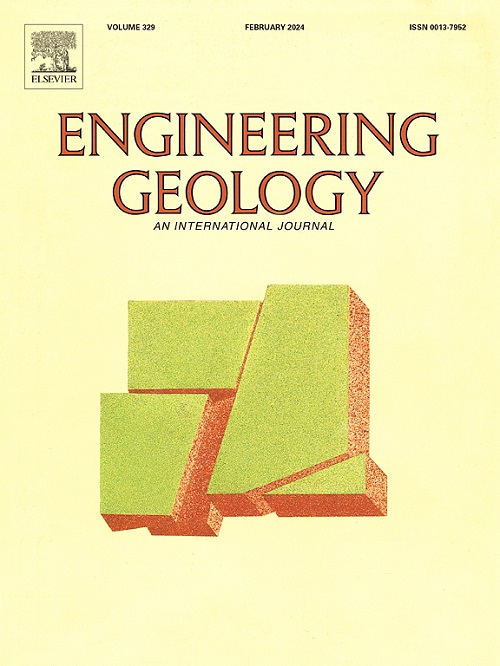Uniaxial compressive strength and crack propagation of debris-ice mixtures: Insights from experiments and particle-based modeling
IF 6.9
1区 工程技术
Q1 ENGINEERING, GEOLOGICAL
引用次数: 0
Abstract
The compressive strength and crack propagation behavior of debris-ice mixtures are crucial for assessing cold-region geohazards, particularly for interpreting the initiation mechanisms of rock-ice avalanches. This study reveals the failure characteristics under uniaxial compression through experiments and discrete element modeling (PFC3D), providing key parameters for the initiation dynamics model of rock-ice avalanches through strength degradation and crack network evolution. The numerical simulation results strongly agree with the experimental results, with a maximum deviation of 6.32 % in the compressive strength and elastic modulus. The findings reveal that rock debris significantly redirect crack propagation by inducing bypass trajectories or crack arrest, rather than allowing direct fracture paths. The compressive strength increases with enlarging rock debris volume fraction but decreases with rising temperature and debris size. The loading rate governs failure mode transitions from plastic deformation (shear-slip dominated) to brittle fracture (tensile-penetration dominated), with peak strength occurring at a critical rate of 1 mm/min in the ductile-to-brittle transition regime. Furthermore, reduced debris porosity enhances the interfacial cementation strength, improving the integrity of debris-ice composite. Crack evolution progresses through three distinct phases: initial nucleation, slow nonlinear propagation, and rapid linear expansion, with tensile cracks dominating 56.9 % of the total fractures. The results provide new insights into the failure mechanisms of multiphase geological materials, offering practical guidance for engineering geology applications, particularly in understanding the initiation and evolution of rock-ice avalanches in periglacial environments, as well as for slope stability prediction and hazard mitigation in cold regions.

碎石-冰混合物的单轴抗压强度和裂纹扩展:来自实验和基于颗粒的建模的见解
碎片-冰混合物的抗压强度和裂纹扩展行为对于评估寒冷地区的地质灾害,特别是解释岩石-冰雪崩的起裂机制至关重要。本研究通过实验和离散元建模(PFC3D)揭示了单轴压缩下岩石的破坏特征,为岩石-冰雪崩强度退化和裂缝网络演化的起裂动力学模型提供了关键参数。数值模拟结果与试验结果吻合较好,抗压强度和弹性模量最大偏差为6.32%。研究结果表明,岩屑通过诱导旁路轨迹或裂缝止裂来显著改变裂缝扩展方向,而不是允许直接裂缝路径。抗压强度随岩屑体积分数的增大而增大,随温度的升高和岩屑尺寸的增大而减小。加载速率决定了从塑性变形(剪切-滑移为主)到脆性断裂(拉伸-渗透为主)的破坏模式转变,峰值强度出现在韧性-脆性过渡状态的临界速率为1 mm/min。此外,降低碎屑孔隙度提高了界面胶结强度,提高了碎屑-冰复合材料的完整性。裂纹演化经历了初始形核、缓慢非线性扩展和快速线性扩展三个阶段,其中拉伸裂纹占断裂总数的56.9%。研究结果为多相地质材料的破坏机制提供了新的见解,为工程地质应用提供了实用指导,特别是在理解冰缘环境下岩冰雪崩的发生和演化,以及在寒冷地区进行边坡稳定性预测和减灾方面。
本文章由计算机程序翻译,如有差异,请以英文原文为准。
求助全文
约1分钟内获得全文
求助全文
来源期刊

Engineering Geology
地学-地球科学综合
CiteScore
13.70
自引率
12.20%
发文量
327
审稿时长
5.6 months
期刊介绍:
Engineering Geology, an international interdisciplinary journal, serves as a bridge between earth sciences and engineering, focusing on geological and geotechnical engineering. It welcomes studies with relevance to engineering, environmental concerns, and safety, catering to engineering geologists with backgrounds in geology or civil/mining engineering. Topics include applied geomorphology, structural geology, geophysics, geochemistry, environmental geology, hydrogeology, land use planning, natural hazards, remote sensing, soil and rock mechanics, and applied geotechnical engineering. The journal provides a platform for research at the intersection of geology and engineering disciplines.
 求助内容:
求助内容: 应助结果提醒方式:
应助结果提醒方式:


